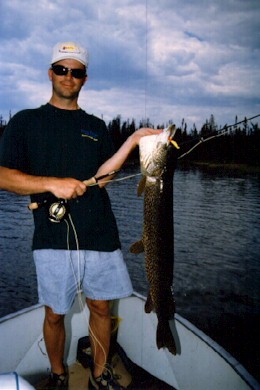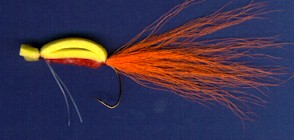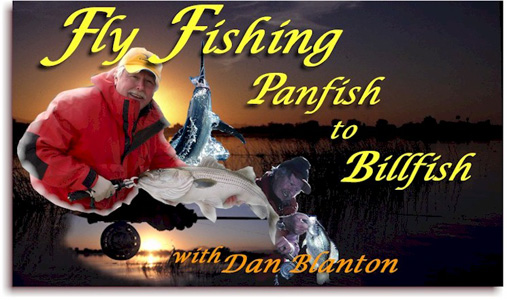The Gartside Gurgler
By Dan Blanton

Rich Grau with one of many trophy pike taken on a pike Gurgler

Lee Haskin’s Pike Gurgler
I was a little (maybe a lot) slow tuning in on to just how effective the Gartside Gurgler was as both a freshwater and saltwater surface fly. Del Brown was the first to really show me the fly’s effectiveness while fishing for stripers and blues on the productive and beautiful flats of Monomoy Inlet. He just slammed both species on his version of Jack’s great Gurgler. Later he gave me a good lesson on its effectiveness on largemouth bass. This took place many seasons ago and it was only within the past few months that I actually got interested in the Gurgler enough to try it out for the first time on Pike – not stripers or blues or bass, but pike. The Pike Gurglers tied for me by Lee Haskin were killers, taking countless trophy pike and a few good lake trout, too. Lee was the other Gurgler devotee who got me to finally try this great surface lure. What took me so long? I can’t say for sure, except that I’ve always had more confidence in subsurface flies, and also that I really hated taking the time to make standard sliders and popping bugs. This fly has changed all that for me, though. Rest assured Gurglers, both large and small will be a permanent part of my fly selection – for any species that will hit on top.
Lee Haskin has generously provided the tying instructions for his version of the Gartside Gurgler and Del Brown has also provided his version, the latter of which will be posted in the future as an article on the Tackle and Technique page.
Jack Gartside is the originator of the Gurgler, a great fly of which there are now many productive variations – all of which are still Gartside Gurglers, regardless of minor differences from the original. The following is how the original Gurgler evolved as told to Noel Mitchell by Jack Gartside:
“Regarding the evolution of the Gurgler: Oddly enough, it evolved from the very simple Foam Beetle of trout fishing fame. This was about twenty years ago. I adapted it first to imitate a floating crab, tying it very large (on a 1/0-3/0 hook) with a short marabou tail and longish pheasant rump hackle Palmering. This worked very well for both tarpon and stripers. Reducing it, I began to tie it as a floating “bug” for bass and panfish, now using regular rooster hackle instead of pheasant for the Palmering. (In this incarnation, the fly is known both as a “Gartside Bug” or “Hoverbug.” I then added a “lip” to this fly so that the fly would “gurgle” or create a commotion to attract largemouth bass or salmon or steelhead. And from there it wasn’t a big step to adapt it to saltwater fishing, stripers and blues in particular (the latter fish being the reason it’s most often tied on a long shank hook, to protect it from teeth); I substituted bucktail for marabou, slimmed down the profile and, viola, the basic Gurgler took shape. I sometimes still use marabou for a tail, also saddles, but most of the time I keep it simple with a slender bucktail tail. It remains my very favorite surface fly to fish for stripers.”
Well, Jack, it certainly fishes well for a lot more species than just those you’ve mentioned. Thanks for a great fly!
